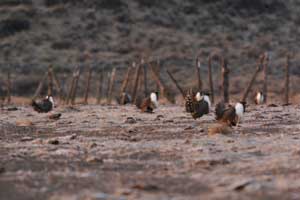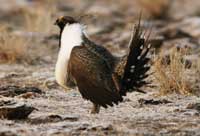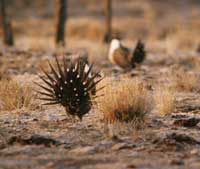 Rising long before dawn, Gunnison sage-grouse watchers arrive at the bird’s breeding grounds to witness an incredible spring ritual. These areas, known as “leks,” are the stage on which male grouse strut to attract female mates. Derived from a Swedish word meaning “play”, the lek activity level is anything but fun as the males occasionally clash or thrash
Rising long before dawn, Gunnison sage-grouse watchers arrive at the bird’s breeding grounds to witness an incredible spring ritual. These areas, known as “leks,” are the stage on which male grouse strut to attract female mates. Derived from a Swedish word meaning “play”, the lek activity level is anything but fun as the males occasionally clash or thrash
one another.
The Gunnison sage-grouse, named after its stronghold in Colorado’s Gunnison Basin, is one-third smaller than their cousins the greater sage-grouse. Both species occur in Utah, but the Gunnison sage-grouse’s range is reduced to portions of southwest Colorado and areas south of the Colorado River around Monticello, Utah.
About the size of a domestic chicken, these upland birds have black bellies and grayish-brown feathers which help them blend into their surroundings. Since the birds don’t run well, they either stay motionless or burst into flight when predators are near.
 The grouse use lek sites found in open areas within or near sagebrush habitat. Like spawning salmon, the sage-grouse return annually to their breeding sites, some which have been active for hundreds of years. This fidelity is exemplified by grouse that returned to their leks flooded during construction of the Blue Mesa Reservoir project in Colorado and the birds displayed on the ice above their ancestral grounds.
The grouse use lek sites found in open areas within or near sagebrush habitat. Like spawning salmon, the sage-grouse return annually to their breeding sites, some which have been active for hundreds of years. This fidelity is exemplified by grouse that returned to their leks flooded during construction of the Blue Mesa Reservoir project in Colorado and the birds displayed on the ice above their ancestral grounds.
During mating displays, males fan their tail feathers like a multi-pointed star, and then create a low hooting or popping sound by forcing air through two inflated yellow air sacs on their breast pouches. Also making some “wing-swooshing noises,” the males dance to attract females. The males also raise their fine head feathers called filoplumes as part of the display.
 What seems chaotic is born of a hierarchy where the dominant male on the lek mates with most of the females. Less dominant males may mate with several females while those males at the low end of the spectrum do a lot of strutting and displaying but rarely engage in breeding. The activity begins before sunrise and ends several hours later or if a coyote or eagle disturbs the performance.
What seems chaotic is born of a hierarchy where the dominant male on the lek mates with most of the females. Less dominant males may mate with several females while those males at the low end of the spectrum do a lot of strutting and displaying but rarely engage in breeding. The activity begins before sunrise and ends several hours later or if a coyote or eagle disturbs the performance.
As their name indicates, sage-grouse are birds of the sagebrush steppe habitat. They are heavily dependent upon this ecosystem for food, nest sites, cover and wintering areas. Since the birds build a nest of grasses and feathers on the ground, they are dependent upon adequate plant cover for protection against predators like hawks, eagles, ravens or coyotes.
At various times of the year, the sage-grouse may move into wetlands, riparian areas or agricultural lands. Here the birds forage on forbs, sage or insects; when the young first hatch their diet is mainly insects, but this shifts to mostly forbs and sagebrush by about 4 weeks of age. Though the adults will also eat insects, sagebrush makes up the bulk of their diet.
The Utah Division of Wildlife Resources is offering two field trips, March 30 and April 13, to view these magnificent birds outside of Monticello. A Friday night lecture precedes the Saturday field trip. Reservations are required; call UDWR at 435-613-3707 to save your space for this fantastic opportunity to view these grouse strutting in the sage.